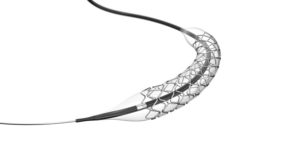
A subanalysis of the Onyx One study found that cardiac death was significantly higher in patients who received single antiplatelet therapy with a P2Y12 inhibitor following percutaneous coronary intervention (PCI) than those who received single antiplatelet therapy with aspirin. Furthermore, single antiplatelet therapy with a P2Y12 inhibitor was a predictor of the combined endpoint of cardiac death/myocardial infarction/stent thrombosis between one and 12 months.
Speaking during PCR eCourse 2020, Azeem Latib (Department of Cardiology, Montefiore Medical Center, New York, USA) reported that the Onyx One trial was a prospective multicentre, randomised controlled trial (with 2,000 patients enrolled) that found “Resolute Onyx [Medtronic] is safe and effective in complex high bleeding risk patients who receive one-month dual antiplatelet therapy [DAPT]”. He added that the aim of the present analysis was to review if there were any differences between in outcomes at one-year between those who received single antiplatelet therapy with aspirin and those who received single antiplatelet therapy with a P2Y12 inhibitor (after discontinuation of DAPT at one month). The primary endpoint, as in the main study, was the rate of cardiac death, myocardial infarction, or stent thrombosis at one year.
“In this subanalysis, we combined the stent groups [the comparator in the study was BioFreedom, Biosensors] and then stratified patients in into two groups depending on which antiplatelet therapy they were taking—so either aspirin monotherapy or P2Y12 monotherapy,” Latib explained. Overall, of those on single antiplatelet therapy at two months after PCI (92% of patients), 56% were on aspirin and 44% were on a P2Y12 inhibitor (predominantly clopidogrel)—the choice between aspirin and a P2Y12 inhibitor was at the operator’s discretion.
According to Latib, there were significant differences between groups in terms of patient characteristics. P2Y12 patients had more atrial fibrillation, more concomitant oral anticoagulation use, and more often met the high bleeding risk criteria while more aspirin patients had renal failure and more myocardial infarction. There were no significant differences in lesion characteristics between groups.

Overall, the rate of the combined endpoint of cardiac death/myocardial infarction/stent thrombosis between one and 12 months did not differ between groups. However, cardiac death was significantly increased in the P2Y12 inhibitor group. “It is not really apparent why this difference occurred, particularly as patients in this group had a lower rate of myocardial infarction compared with patients in the aspirin group. They had a similar rate of stroke and stent thrombosis and also a numerical lower rate of bleeding,” Latib observed.
To further investigate the apparent link between cardiac death and P2Y12 inhibitor monotherapy therapy, Latib and colleagues performed a Kaplan-Meier analysis. They again found no significant differences between groups in the combined endpoint but still found a difference in cardiac death (increased with the P2Y12 inhibitor). “We performed a multivariate cox aggression to try to identify what the potential predictors of cardiac death/myocardial infarction/stent thrombosis, between one and 12 months, were… choice of single antiplatelet therapy seemed to be an important risk factor,” he noted.
Concluding, Latib said: “Adverse ischaemic and bleeding rates between one and 12 months were similar irrespective of the single antiplatelet agent that was continued, except for cardiac death which was higher with P2Y12 inhibitors”. He added that further analyses “will expand the dataset with the ONYX Clear study patients”.










